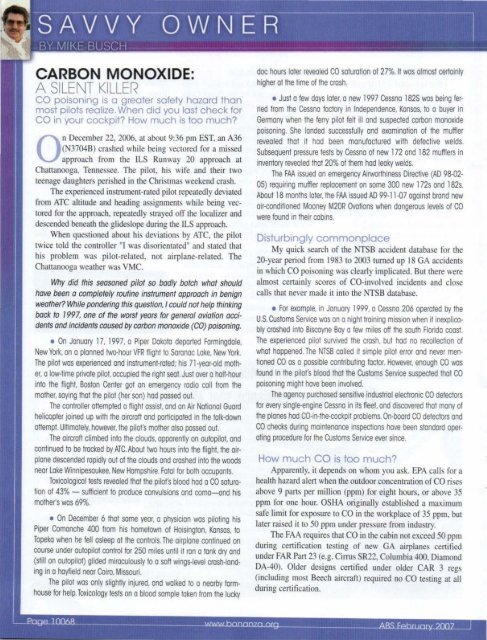February 2007 - American Bonanza Society
February 2007 - American Bonanza Society
February 2007 - American Bonanza Society
You also want an ePaper? Increase the reach of your titles
YUMPU automatically turns print PDFs into web optimized ePapers that Google loves.
CARBON MONOXIDE:A SILENT KILLERco pOisoning is a greater safety hazard thanmost pilots realize. When did you last check forCO in your cockpit? How much is too much?On December 22, 2006, at about 9:36 pm EST, an A36(N3704B) crashed while being vectored for a missedapproach from the lLS Runway 20 approach atChattanooga, Tennessee. The pilot, his wife and their twoteenage daughters perished in the Christmas weekend crash.The experienced instrument-rated pilot repeatedly deviatedfrom ATC altitude and heading assignments while being vectoredfor the approach, repeatedly strayed off the localizer anddescended beneath the glideslope during the lLS approach.When questioned about his deviations by ATC, the pilottwice told the controller "[ was disorientated" and stated thathis problem was pilot-related, not airplane-related. TheChattanooga weather was VMC.Why did this seasoned pilot so badly botch what shouldhave been a completely routine instrument approach in benignweather? While pondering this question, I could not help thinkingback to 1997, one of the worst years for general aviation accidentsand incidents caused by carbon monoxide (CO) poisoning.• On January 17, 1997, a Piper Dakota deported Farmingdale,New York, on a planned two-hour VFR flight to Saranac lake, New York.The pilot was experienced and instrument-rated; his 71-year-old mother,a tow-time private pilot, occupied the right seal. Just over a half-hourinto the flight, Boston Center got on emergency radio cotl from themother, saying that the pilot (her son) hod passed oul.The controller aHempted a ftight assist, and on Air Notional Guardhelicopter joined up with the aircraft and porticipated in the talk-downaHempl. Ultimately, however, the pilot's mother also passed oul.The aircraft climbed into the clouds, apparently on autopilot, andcontinued to be tracked by ATC. About two hours into the flight, the airplanedescended rapidly out of the clouds and crashed into the woodsnear lake Winnipesaukee, New Hampshire. Fatal for both occupants.Toxicological tests revealed that the pilot's blood had a CO saturationof 43% - sufficient to produce convulsions and coma- and hismother's was 69%.• On December 6 that some year, a physician was piloting hisPiper Comanche 400 from his hometown of Hoisington, Kansas, toTopeka when he fell asleep at the controls, The airplane continued oncourse under autopilot control for 250 miles until it ron a tonk dry and(still on autopilot) glided miraculously to a soft wings-level crash-landingin a hayfield near Cairo, Missouri.The pilot was only slightly injured, and walked to a nearby farmhousefor help. Toxicology tests on a blood sample token from the luckydoc hours later revealed CO saturation of 27%. It was almost certainlyhigher at the time of the crash.• Just a few days later, a new 1997 Cessna 182S was being ferriedfrom fhe Cessna factory in Independence, Kansas, to a buyer inGermany when the ferry pilot felt ill and suspected carbon monoxidepOisoning. She landed successfully and examination of the mufflerrevealed that it had been manufactured with defective welds.Subsequent pressure tests by Cessna of new 172 and 182 mufflers ininventory revealed that 20% of them had leaky welds.The FAA issued on emergency Airworthiness Directive (AD 98-02-05) requiring muffler replacement on some 300 new 172s and 1 B2s.About 18 months later, the FAA issued AD 99-11-07 against brand newair-conditioned Mooney M20R Ovations when dangerous levels of COwere found in their cabins.Disturbingly commonplaceMy quick search of the NTSB accident database for the20-year period from t 983 to 2003 turned up t 8 GA accidentsin which CO poisoning was clearly implicated, But there werealmost certainly scores of CO-involved incidents and closecalls that never made it into the NTSB database.• For example, in January 1999, a Cessna 206 operated by theU,S. Customs Service was on a night training mission when it inexplicablycrashed into Biscayne Boy a few miles off the south Florida coast.The experienced pilot survived the crash, but hod no recollection ofwhat happened, The NTSB called it simple pilot error and never mentionedCO as a possible contributing factor. However, enough CO wasfound in the pilot's blood that the Customs Service suspected that COpoisoning might have been involved,The agency purchased sensitive industrial electronic CO detectorsfor every single-engine Cessna in its fleet, and discovered that many ofthe planes hod CO-in-the-cockpit problems. On-boord CO detectors andCO checks during maintenance inspections have been standard operatingprocedure for the Customs Service ever since.How much CO is too much?Apparently, it depends on whom you ask. EPA calls for ahealth hazard alert when the outdoor concentration of CO risesabove 9 parts per million (ppm) for eight hours, or above 35ppm for one hour. OSHA originally established a maximumsafe limit for exposure to CO in the workplace of 35 ppm, butlater raised it to 50 ppm under pressure from industry.The FAA requires that CO in the cabin not exceed 50 ppmduring certification testing of new GA airptanes cenifiedunder FAR Pan 23 (e,g, Cirrus SR22, Cotumbia 400, DiamondDA-40). Older designs certified under older CAR 3 regs(i ncluding most Beech aircraft) requ ired no CO testing at allduring certification.

















